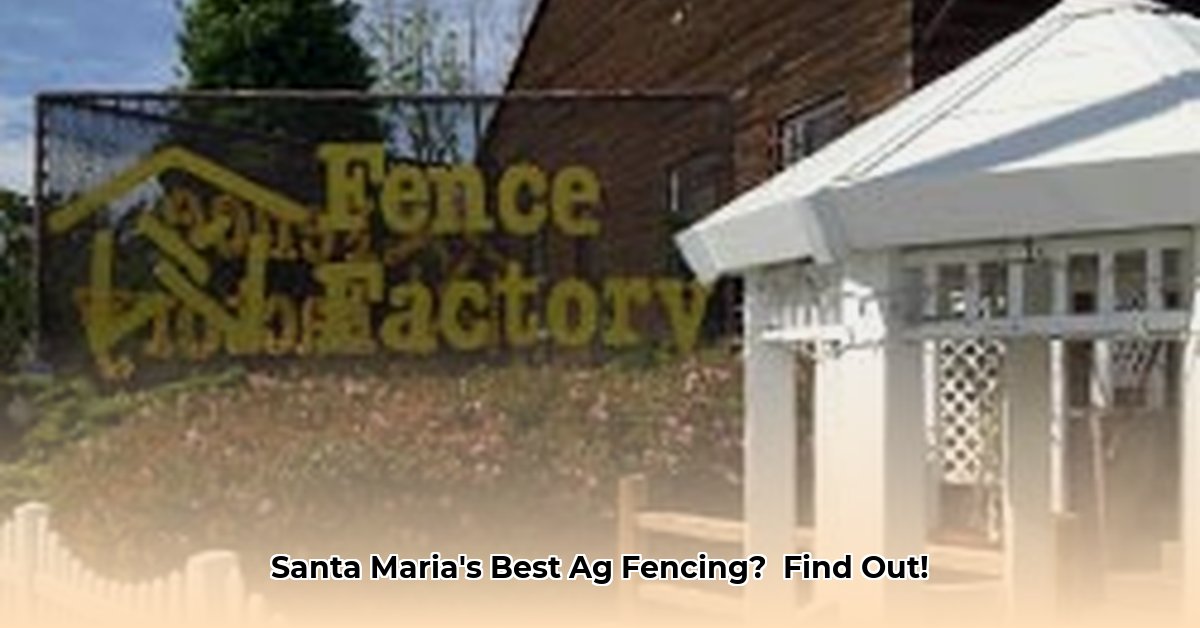
Choosing the right agricultural fencing for your Santa Maria farm is a significant decision impacting animal safety, crop protection, property aesthetics, and value. This guide explores the options available from Fence Factory in Santa Maria, a long-standing provider of agricultural fencing solutions. We'll compare various fencing types, discuss installation and sustainability considerations, and help you budget effectively.
Picking the Perfect Farm Fence: Wood, Vinyl, Wire, and Electric
Fence Factory offers a variety of fencing materials, each with unique strengths and weaknesses in Santa Maria's climate. The ideal choice depends on your specific needs and budget.
| Fencing Material | Pros | Cons | Approximate Cost Range | Estimated Lifespan (Years) | Maintenance Needs |
|---|---|---|---|---|---|
| Wood | Natural look, potentially lower initial cost, readily available. | Requires regular maintenance (painting, staining, repairs), shorter lifespan. | Low to Moderate | 10-15 | High (regular painting/staining) |
| Vinyl | Low maintenance, long-lasting, resists rot and insects, many colors. | Higher initial cost, less flexible than wood, may crack under significant impact. | Moderate to High | 20-30 | Low (occasional cleaning) |
| Wire | Versatile, good for livestock and smaller areas, relatively inexpensive. | Easily damaged, requires regular inspection and repair. | Low to Moderate | 5-15 | Moderate (regular checks & repairs) |
| Electric | Effective deterrent, versatile, can be combined with other types. | Requires a power source, can be dangerous if improperly installed. | Moderate to High | Highly Variable | Low to Moderate (check power source) |
Note: Cost and lifespan are estimates. Actual figures depend on fence length, height, features (gates), and site conditions.
Professional Installation: An Investment in Longevity
Fence Factory provides professional installation services. Professional installation ensures structural integrity, maximizing fence lifespan and minimizing future maintenance. Inquire about their warranty—a strong indicator of their confidence and commitment to quality workmanship. A well-installed fence is a significant long-term investment.
Sustainability: Prioritizing Environmental Responsibility
While Fence Factory offers various fencing materials, information on their sustainable sourcing practices isn't readily available. This lack of transparency makes it difficult to fully evaluate the environmental impact of their products. To encourage more responsible choices, ask Fence Factory these questions:
- Wood Sourcing: Is the wood from sustainably managed forests (e.g., Forest Stewardship Council [FSC] certified)?
- Recycled Content: Does the vinyl or metal fencing contain recycled materials?
- Carbon Footprint: What is the overall environmental impact of production and transportation?
Farmers should consider the entire life cycle of their fencing – from material sourcing to eventual disposal or recycling. Promoting sustainable practices benefits both the farm and the environment.
Budgeting for Your Farm Fence: A Comprehensive Approach
Fence costs depend on materials, property size, installation complexity (terrain), additional features (gates), and site preparation. Obtain multiple quotes, comparing not just initial costs but also long-term maintenance and eventual replacement expenses. A well-planned budget ensures a successful and cost-effective project.
Ready to Get Started?
Contact Fence Factory directly for personalized quotes and detailed information on materials, installation, warranties, and sustainability practices. Informed decision-making ensures a durable, long-lasting, and environmentally responsible fencing solution for your agricultural needs. 1